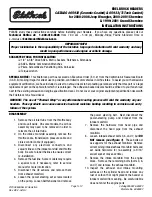
Adjustments
36
Adjustments
Sitting safely
The ideal sitting position can make a vital
contribution to relaxed, fatigue-free driving.
The sitting position of the occupants also
plays an important role for passive safety
together with the safety belts and airbags
in an accident. To ensure that the safety
systems operate with optimal efficiency,
we strongly urge you to observe the
instructions contained in the following sec-
tion.
For additional information on transporting
children safely, refer to page
Sitting safely with airbags
Always maintain an adequate dis-
tance between yourself and the air-
bags. Always hold the steering wheel by
its rim with hands at the 9 o'clock and
3 o'clock positions, to minimize the risk of
injuries to your hands and arms in the event
of airbag deployment.
No one and nothing is to come between the
airbags and the seat occupant.
Do not use the cover of the front airbag on
the front passenger side as a storage area.
Make sure that the front passenger is sit-
ting correctly and does not rest feet or legs
on the instrument panel, otherwise leg inju-
ries can occur if the knee and front airbag
are triggered.
Never let an occupant's head rest near or
on a side airbag because the inflating air-
bag could cause a serious or fatal injury.
<
Even if you adhere to all the instructions
injuries resulting from contact with airbags
cannot be fully excluded, depending on the
circumstances. The ignition and inflation
noise may provoke a mild hearing loss in
extremely sensitive individuals. This effect
is usually only temporary.
For airbag locations and additional infor-
mation on airbags, refer to page
Sitting safely with safety belts
Fasten your safety belt before starting any
trip. Airbags complement the safety belt as
an additional safety device, but they do not
represent a substitute.
At all times, occupants should sit
upright and be properly restrained –
infants and small children in appropriate
child-restraint systems; larger children and
adults using the safety belts.
Never allow more than one person to wear
a single safety belt. Never allow infants or
small children to ride in a passenger's lap.
Expectant mothers should always wear
their safety belts, taking care to position
the lap belt against the lower hips, where it
will not exert pressure against the abdomi-
nal area.
Do not route the belt across your neck, or
run it across sharp edges. Be sure that the
belt does not become caught or jammed.
Avoid twisting the belt while routing it firmly
across the hips and shoulder. Do not allow
the belt to rest against hard or fragile
objects. Otherwise, in the event of a frontal
impact, a loose lap belt could slide over
your hips, leading to abdominal injury.
Avoid wearing clothing that prevents the
belt from fitting properly and pull the lap
belt periodically to readjust the tension
across your shoulder in order to avoid a
reduction in the retention effect of the
safety belt.
<
For instructions on operating safety belts,
refer to page
Seats
Note before adjusting
Never attempt to adjust your seat
while the vehicle is moving. The seat
could respond with unexpected move-
ment, and the ensuing loss of vehicle con-
trol could lead to an accident.
Also on the passenger's side, do not incline
Online Edition for Part No. 01 41 0 158 159 - © 02/04 BMW AG
Summary of Contents for 525I SEDAN
Page 2: ...Online Edition for Part No 01 41 0 158 159 02 04 BMW AG...
Page 10: ...Online Edition for Part No 01 41 0 158 159 02 04 BMW AG...
Page 26: ...Online Edition for Part No 01 41 0 158 159 02 04 BMW AG...
Page 104: ...Online Edition for Part No 01 41 0 158 159 02 04 BMW AG...
Page 110: ...Online Edition for Part No 01 41 0 158 159 02 04 BMW AG...
Page 128: ...Online Edition for Part No 01 41 0 158 159 02 04 BMW AG...
Page 146: ...Online Edition for Part No 01 41 0 158 159 02 04 BMW AG...
Page 164: ...Online Edition for Part No 01 41 0 158 159 02 04 BMW AG...
Page 196: ...Online Edition for Part No 01 41 0 158 159 02 04 BMW AG...
Page 223: ...5 US En...
















































